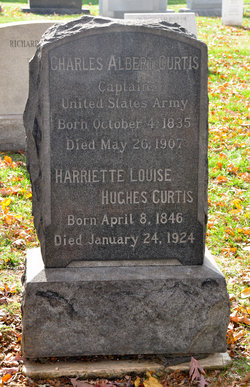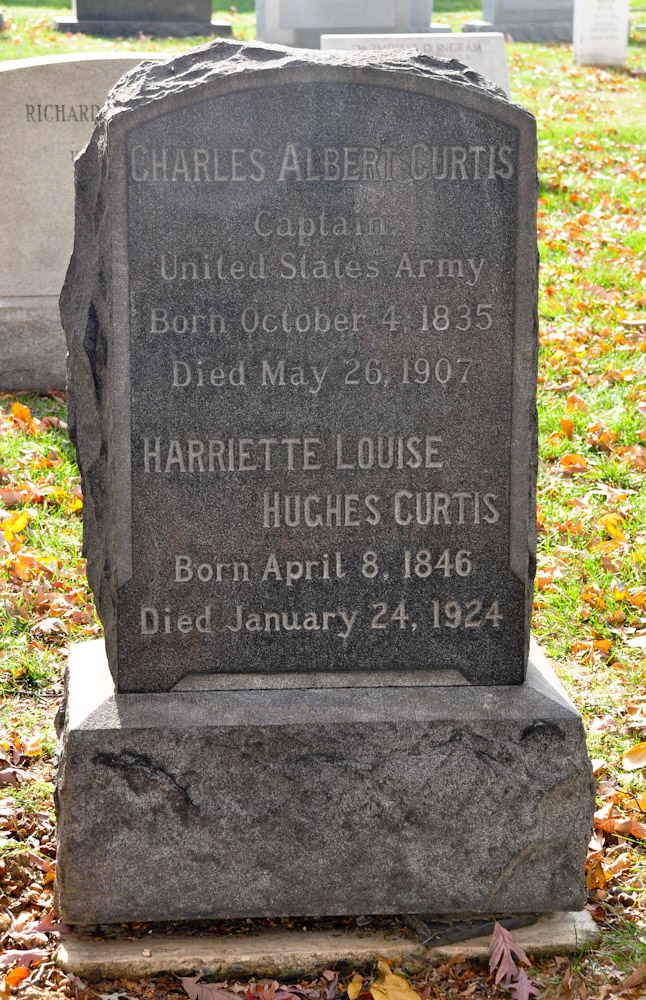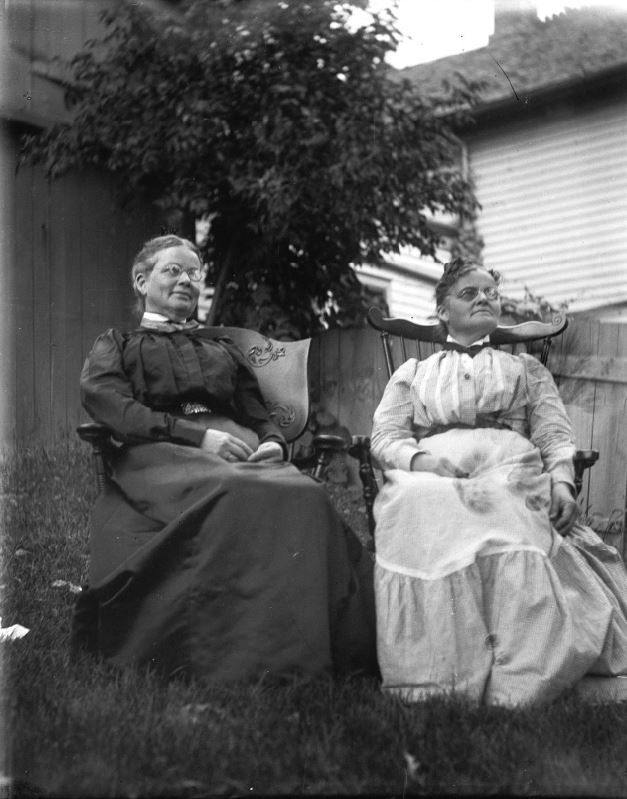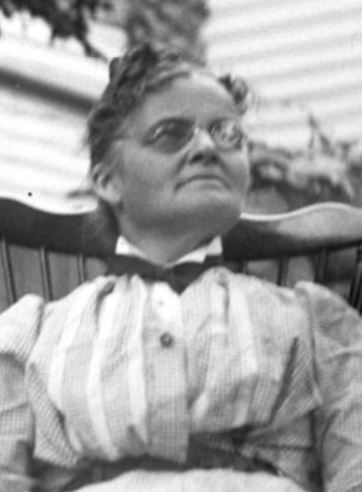Charles Albert Curtis and Harriet/Harriette Louise Hughes were married May 17, 1866 in Holderness, Grafton county New Hampshire.
Mrs. Charles A Curtis.
Mrs Harriett L H Curtis died at Ashland January 24th of uraemic poisoning in the seventy-seventh year of her age. When we say that a person has died in the very home that they were born, we naturally think they have lived a calm and eventless life. Harriett Louise Hughes was born in Holderness as it was, April 8, 1846. At twenty she married a young officer of the Regular Army, Charles A Curtis, a native of Maine and who, through circumstances growing out of the enlistments of students in the Civil War, had the unique distinction of being a Bachelor of Arts in both Norwich University and in Vermont and Bowdoin College in Maine. The day after her wedding she started with her husband for New Mexico. The railroad then ended up at the Missouri River. The Great Plains were still in their pristine state. As the regiment proceeded on its march of eleven hundred miles, great herds of buffalo, herds of antelope and many lesser animals were nearly always in sight. Now and then droves of wild horses and cavalcades of Indians enlivened the great scene. How strange peaceful New Hampshire is to what she lived through as a young woman. She heard the war cry of Indians outside the stockade and saw her husband brought in with an arrow in his ribs on one occasion. For three nights she came to the head of the stairs at intervals to ask soldiers in the hallway below if the 3000 Navajo warriors on the hill about the fort had begun to move on the little garrison of one hundred men, which her husband though only a lieutenant, happened to command. The chiefs of the revolted Indians could not agree upon a place of attack and on the fourth day a regiment of cavalreymen appeared and the Indians returned to obedience. Where the big city of Pueblo now stands, she arrived when the sixteen white people, who had been the inhabitants of the place the evening before, were lying on the ground, scalped. Bear meat and wild turkey meat were a frequent part of the fare. Rattlesnakes and centipedes were common. Public proclamations were in Spanish, not English the trapper we now see only in the movies existed in flesh. The famous Kit Carson was a friend of her husband. Moving about, as army officers did, she saw a number of states. She was well acquainted with Vermont, Minnesota and Wisconsin. She spent some time in Chicago. She travelled in South Dakota while it was still new country. She spent a summer in Oregon and a year later visited British Columbia. In 1901 she travelled by train over the same route she travelled by wagon in 1866, going to Arizona. Since June 1907, she has lived on her farm in Ashland. Her acquaintances here were not wide, but possibly some valued it. She was a woman of mental and physical vigorous to the time of an operation in 1921. The picture of her driving her high-headed, spirited horse, has not faded out of the public mind. She was the daughter of Barnet and Martha Clark Hughes, a descendant of the first white man who set foot in New Hampshire. She is survived by James B Hughes and John C Hughes of Ashland, brothers, and her children Warden A of Ashland, Colorado Lawrence A of California, Mrs Wallace W Chickering of Chicago and Mrs. Earl B. Rose of Berkeley, California, who with their twelve children mourn her loss. The Plymouth Record, March, 26, 1924, p2. Harriet Louise (Hughes) Curtis died 7:55 pm on January 24, 1924.
Following is the obituary of Harriette Louise Hughes Curtis that can be found on page171 of the Granite Monthly, Vol 25, No 2, February 1924.
Died at Ashland, January 24th, Harriette Louise Hughes Curtis, in the seventy-seventh year of her age.
It is not often that even in New England one dies at the very home where one was born. And nothing could have seemed stranger than a little girl sitting by her mother's coffin in 1863 (actually it was 1862. BLH) in the very same room and on the same sofa where her son was to sit by her coffin, than that her body would be taken to that very Virginia to which she has just sent the still preserved letter describing her mother's death to the two brothers in the Union Army.
Her father was Barnet Hughes of Windham, grandson of a lieutenant in the Continental Army. Her mother was Martha Lane Clark of Franklin, whose father was president of the New Hampshire Senate. She was a descendant of the first white family in New Hampshire, the Hiltons; of General Dearborn, commander-in-Chief of the United States Army in the 1812 war, of Governor Dudley of Massachusetts Bay, through whom she went back to King Francis First of France, whose daughter married Earl Dudley. By this connection, like many other New Hampshire folks of unmistakable Yankee lineage, she was a descendant of Charlemagne.
At the age of 20 she married Charles A. Curtis, an officer of the regular army, who had the unique distinction of being a graduate of both Norwich University in Vermont and Bowdoin College in Maine, who was once President of Norwich University and died a member of the faculty of the University of Wisconsin. The day of the wedding she set out for the Far West. She rode in a wagon train from Leavenworth, Kansas, to Ft Sumner, New Mexico. The great herds of buffalo still covered the plains, herds of antelope, droves of wild horses, packs of Wolves, cavalcades of Indians were often in sight. Indian wars had not ceased. She saw her husband brought in the door with an arrow in his ribs. When the first child was a few months old, the Navajos, on whose reservation she lived, revolted. Lulled by confidence, the garrison had become reduced to one hundred soldiers, who with forty clerks, constituted the force her husband commanded, for though only a lieutenant he happened to be the ranking officer. Three thousand warriors surrounded the fort. On three successive nights, a friendly Indian brought word they would be attacked that night. With the air resounding all night with the din of the war dance, the young mother would at intervals call down the stairs to the soldier standing at the door, "Do you think they are going to attack?" The Indians could not agree on a plan of attack and on the fourth morning a regiment of cavalry galloped in and the Indians returned to allegiance. She was on the fringe of fighting for several years. She was with the column which marched to the settlement that is now the big city of Pueblo, Colorado, and saw lying on the ground, scalped, the sixteen people who had been the white inhabitants the night before. Granite Monthly, v56, p171, Feb 1924.
Charles Albert Curtis and Harriet/Harriette Louise Hughes were married May 17, 1866 in Holderness, Grafton county New Hampshire.
Mrs. Charles A Curtis.
Mrs Harriett L H Curtis died at Ashland January 24th of uraemic poisoning in the seventy-seventh year of her age. When we say that a person has died in the very home that they were born, we naturally think they have lived a calm and eventless life. Harriett Louise Hughes was born in Holderness as it was, April 8, 1846. At twenty she married a young officer of the Regular Army, Charles A Curtis, a native of Maine and who, through circumstances growing out of the enlistments of students in the Civil War, had the unique distinction of being a Bachelor of Arts in both Norwich University and in Vermont and Bowdoin College in Maine. The day after her wedding she started with her husband for New Mexico. The railroad then ended up at the Missouri River. The Great Plains were still in their pristine state. As the regiment proceeded on its march of eleven hundred miles, great herds of buffalo, herds of antelope and many lesser animals were nearly always in sight. Now and then droves of wild horses and cavalcades of Indians enlivened the great scene. How strange peaceful New Hampshire is to what she lived through as a young woman. She heard the war cry of Indians outside the stockade and saw her husband brought in with an arrow in his ribs on one occasion. For three nights she came to the head of the stairs at intervals to ask soldiers in the hallway below if the 3000 Navajo warriors on the hill about the fort had begun to move on the little garrison of one hundred men, which her husband though only a lieutenant, happened to command. The chiefs of the revolted Indians could not agree upon a place of attack and on the fourth day a regiment of cavalreymen appeared and the Indians returned to obedience. Where the big city of Pueblo now stands, she arrived when the sixteen white people, who had been the inhabitants of the place the evening before, were lying on the ground, scalped. Bear meat and wild turkey meat were a frequent part of the fare. Rattlesnakes and centipedes were common. Public proclamations were in Spanish, not English the trapper we now see only in the movies existed in flesh. The famous Kit Carson was a friend of her husband. Moving about, as army officers did, she saw a number of states. She was well acquainted with Vermont, Minnesota and Wisconsin. She spent some time in Chicago. She travelled in South Dakota while it was still new country. She spent a summer in Oregon and a year later visited British Columbia. In 1901 she travelled by train over the same route she travelled by wagon in 1866, going to Arizona. Since June 1907, she has lived on her farm in Ashland. Her acquaintances here were not wide, but possibly some valued it. She was a woman of mental and physical vigorous to the time of an operation in 1921. The picture of her driving her high-headed, spirited horse, has not faded out of the public mind. She was the daughter of Barnet and Martha Clark Hughes, a descendant of the first white man who set foot in New Hampshire. She is survived by James B Hughes and John C Hughes of Ashland, brothers, and her children Warden A of Ashland, Colorado Lawrence A of California, Mrs Wallace W Chickering of Chicago and Mrs. Earl B. Rose of Berkeley, California, who with their twelve children mourn her loss. The Plymouth Record, March, 26, 1924, p2. Harriet Louise (Hughes) Curtis died 7:55 pm on January 24, 1924.
Following is the obituary of Harriette Louise Hughes Curtis that can be found on page171 of the Granite Monthly, Vol 25, No 2, February 1924.
Died at Ashland, January 24th, Harriette Louise Hughes Curtis, in the seventy-seventh year of her age.
It is not often that even in New England one dies at the very home where one was born. And nothing could have seemed stranger than a little girl sitting by her mother's coffin in 1863 (actually it was 1862. BLH) in the very same room and on the same sofa where her son was to sit by her coffin, than that her body would be taken to that very Virginia to which she has just sent the still preserved letter describing her mother's death to the two brothers in the Union Army.
Her father was Barnet Hughes of Windham, grandson of a lieutenant in the Continental Army. Her mother was Martha Lane Clark of Franklin, whose father was president of the New Hampshire Senate. She was a descendant of the first white family in New Hampshire, the Hiltons; of General Dearborn, commander-in-Chief of the United States Army in the 1812 war, of Governor Dudley of Massachusetts Bay, through whom she went back to King Francis First of France, whose daughter married Earl Dudley. By this connection, like many other New Hampshire folks of unmistakable Yankee lineage, she was a descendant of Charlemagne.
At the age of 20 she married Charles A. Curtis, an officer of the regular army, who had the unique distinction of being a graduate of both Norwich University in Vermont and Bowdoin College in Maine, who was once President of Norwich University and died a member of the faculty of the University of Wisconsin. The day of the wedding she set out for the Far West. She rode in a wagon train from Leavenworth, Kansas, to Ft Sumner, New Mexico. The great herds of buffalo still covered the plains, herds of antelope, droves of wild horses, packs of Wolves, cavalcades of Indians were often in sight. Indian wars had not ceased. She saw her husband brought in the door with an arrow in his ribs. When the first child was a few months old, the Navajos, on whose reservation she lived, revolted. Lulled by confidence, the garrison had become reduced to one hundred soldiers, who with forty clerks, constituted the force her husband commanded, for though only a lieutenant he happened to be the ranking officer. Three thousand warriors surrounded the fort. On three successive nights, a friendly Indian brought word they would be attacked that night. With the air resounding all night with the din of the war dance, the young mother would at intervals call down the stairs to the soldier standing at the door, "Do you think they are going to attack?" The Indians could not agree on a plan of attack and on the fourth morning a regiment of cavalry galloped in and the Indians returned to allegiance. She was on the fringe of fighting for several years. She was with the column which marched to the settlement that is now the big city of Pueblo, Colorado, and saw lying on the ground, scalped, the sixteen people who had been the white inhabitants the night before. Granite Monthly, v56, p171, Feb 1924.
Gravesite Details
Widow Of Chas A
Family Members
Sponsored by Ancestry
Advertisement
Advertisement

















